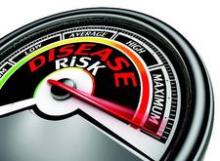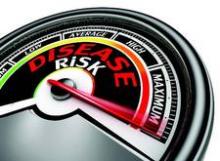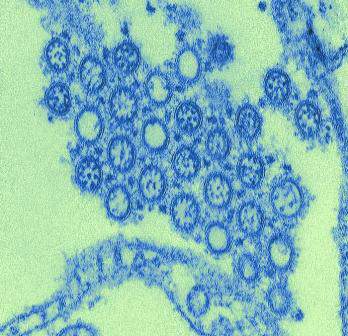User login
Study: One-third of Patients With Bipolar Disorders Abnormally Metabolized Glucose
One-third of patients with bipolar disorders abnormally metabolized glucose, in a study of outpatients from two university hospitals in Germany.
The study included 85 euthymic patients with bipolar disorders, who underwent an oral glucose tolerance test, laboratory screening, and clinical measurements.
Seven percent of the patients tested positive for diabetes mellitus, while 27% of the patients showed prediabetic abnormalities, including abnormalities in glucose metabolism. Patients in both of these groups had significantly lower quality of life and global functioning.
Additional study findings were that higher body mass index, leptin, triglycerides, and C-reactive protein levels significantly increased the likelihood of an individual having pre-diabetes abnormalities or diabetes.
Low sample size was a weakness of the study, according to Karolina Leopold and her colleagues.
Read the full study in the Journal of Affective Disorders (doi: 10.1016/j.jad.2015.09.041).
One-third of patients with bipolar disorders abnormally metabolized glucose, in a study of outpatients from two university hospitals in Germany.
The study included 85 euthymic patients with bipolar disorders, who underwent an oral glucose tolerance test, laboratory screening, and clinical measurements.
Seven percent of the patients tested positive for diabetes mellitus, while 27% of the patients showed prediabetic abnormalities, including abnormalities in glucose metabolism. Patients in both of these groups had significantly lower quality of life and global functioning.
Additional study findings were that higher body mass index, leptin, triglycerides, and C-reactive protein levels significantly increased the likelihood of an individual having pre-diabetes abnormalities or diabetes.
Low sample size was a weakness of the study, according to Karolina Leopold and her colleagues.
Read the full study in the Journal of Affective Disorders (doi: 10.1016/j.jad.2015.09.041).
One-third of patients with bipolar disorders abnormally metabolized glucose, in a study of outpatients from two university hospitals in Germany.
The study included 85 euthymic patients with bipolar disorders, who underwent an oral glucose tolerance test, laboratory screening, and clinical measurements.
Seven percent of the patients tested positive for diabetes mellitus, while 27% of the patients showed prediabetic abnormalities, including abnormalities in glucose metabolism. Patients in both of these groups had significantly lower quality of life and global functioning.
Additional study findings were that higher body mass index, leptin, triglycerides, and C-reactive protein levels significantly increased the likelihood of an individual having pre-diabetes abnormalities or diabetes.
Low sample size was a weakness of the study, according to Karolina Leopold and her colleagues.
Read the full study in the Journal of Affective Disorders (doi: 10.1016/j.jad.2015.09.041).
FROM THE JOURNAL OF AFFECTIVE DISORDERS
Study: One-third of patients with bipolar disorders abnormally metabolized glucose
One-third of patients with bipolar disorders abnormally metabolized glucose, in a study of outpatients from two university hospitals in Germany.
The study included 85 euthymic patients with bipolar disorders, who underwent an oral glucose tolerance test, laboratory screening, and clinical measurements.
Seven percent of the patients tested positive for diabetes mellitus, while 27% of the patients showed prediabetic abnormalities, including abnormalities in glucose metabolism. Patients in both of these groups had significantly lower quality of life and global functioning.
Additional study findings were that higher body mass index, leptin, triglycerides, and C-reactive protein levels significantly increased the likelihood of an individual having pre-diabetes abnormalities or diabetes.
Low sample size was a weakness of the study, according to Karolina Leopold and her colleagues.
Read the full study in the Journal of Affective Disorders (doi: 10.1016/j.jad.2015.09.041).
One-third of patients with bipolar disorders abnormally metabolized glucose, in a study of outpatients from two university hospitals in Germany.
The study included 85 euthymic patients with bipolar disorders, who underwent an oral glucose tolerance test, laboratory screening, and clinical measurements.
Seven percent of the patients tested positive for diabetes mellitus, while 27% of the patients showed prediabetic abnormalities, including abnormalities in glucose metabolism. Patients in both of these groups had significantly lower quality of life and global functioning.
Additional study findings were that higher body mass index, leptin, triglycerides, and C-reactive protein levels significantly increased the likelihood of an individual having pre-diabetes abnormalities or diabetes.
Low sample size was a weakness of the study, according to Karolina Leopold and her colleagues.
Read the full study in the Journal of Affective Disorders (doi: 10.1016/j.jad.2015.09.041).
One-third of patients with bipolar disorders abnormally metabolized glucose, in a study of outpatients from two university hospitals in Germany.
The study included 85 euthymic patients with bipolar disorders, who underwent an oral glucose tolerance test, laboratory screening, and clinical measurements.
Seven percent of the patients tested positive for diabetes mellitus, while 27% of the patients showed prediabetic abnormalities, including abnormalities in glucose metabolism. Patients in both of these groups had significantly lower quality of life and global functioning.
Additional study findings were that higher body mass index, leptin, triglycerides, and C-reactive protein levels significantly increased the likelihood of an individual having pre-diabetes abnormalities or diabetes.
Low sample size was a weakness of the study, according to Karolina Leopold and her colleagues.
Read the full study in the Journal of Affective Disorders (doi: 10.1016/j.jad.2015.09.041).
FROM THE JOURNAL OF AFFECTIVE DISORDERS
Antidepressant use associated with subsequent mania diagnosis
Patients with unipolar depression who use antidepressants may increase their risk of subsequently being diagnosed with mania/bipolar disorder, a retrospective cohort study conducted in the United Kingdom showed.
“Our findings demonstrate a significant association between antidepressant therapy in patients with unipolar depression and an increased incidence of mania. This association remained significant after adjusting for age and gender,” wrote Dr. Rashmi Patel of King’s College London and his colleagues.
The study comprised 21,012 adults who were diagnosed with depression and were receiving secondary mental health care for unipolar depression between April 1, 2006, and March 31, 2013. The researchers used electronic health records to determine which patients had used antidepressants prior to being diagnosed with depression and were subsequently diagnosed with mania or bipolar disorder, as well as the dates of the patients’ diagnoses. Patients were followed up to March 31, 2014.
Just under 1,000 (994) of the study participants were diagnosed with mania or bipolar disorder, representing 10.9 per 1,000 person-years. All types of antidepressants taken by the patients were associated with an increased incidence of mania/bipolar disorder (unadjusted hazard ratio greater than 1.0 for all antidepressants), with incidence rates ranging from 13.1 (tricyclic antidepressants) to 19.1 (trazodone) per 1,000 person-years.
“Future research should not only focus on which classes of antidepressants are most associated with mania, but also on other associated factors in order to guide clinicians of the risk of mania in people with depression prior to prescribing antidepressant therapy,” the investigators noted. They disclosed having received research funding from various sources.
Read the full study in BMJ Open (doi: 10.1136/bmjopen-2015-008341).
Patients with unipolar depression who use antidepressants may increase their risk of subsequently being diagnosed with mania/bipolar disorder, a retrospective cohort study conducted in the United Kingdom showed.
“Our findings demonstrate a significant association between antidepressant therapy in patients with unipolar depression and an increased incidence of mania. This association remained significant after adjusting for age and gender,” wrote Dr. Rashmi Patel of King’s College London and his colleagues.
The study comprised 21,012 adults who were diagnosed with depression and were receiving secondary mental health care for unipolar depression between April 1, 2006, and March 31, 2013. The researchers used electronic health records to determine which patients had used antidepressants prior to being diagnosed with depression and were subsequently diagnosed with mania or bipolar disorder, as well as the dates of the patients’ diagnoses. Patients were followed up to March 31, 2014.
Just under 1,000 (994) of the study participants were diagnosed with mania or bipolar disorder, representing 10.9 per 1,000 person-years. All types of antidepressants taken by the patients were associated with an increased incidence of mania/bipolar disorder (unadjusted hazard ratio greater than 1.0 for all antidepressants), with incidence rates ranging from 13.1 (tricyclic antidepressants) to 19.1 (trazodone) per 1,000 person-years.
“Future research should not only focus on which classes of antidepressants are most associated with mania, but also on other associated factors in order to guide clinicians of the risk of mania in people with depression prior to prescribing antidepressant therapy,” the investigators noted. They disclosed having received research funding from various sources.
Read the full study in BMJ Open (doi: 10.1136/bmjopen-2015-008341).
Patients with unipolar depression who use antidepressants may increase their risk of subsequently being diagnosed with mania/bipolar disorder, a retrospective cohort study conducted in the United Kingdom showed.
“Our findings demonstrate a significant association between antidepressant therapy in patients with unipolar depression and an increased incidence of mania. This association remained significant after adjusting for age and gender,” wrote Dr. Rashmi Patel of King’s College London and his colleagues.
The study comprised 21,012 adults who were diagnosed with depression and were receiving secondary mental health care for unipolar depression between April 1, 2006, and March 31, 2013. The researchers used electronic health records to determine which patients had used antidepressants prior to being diagnosed with depression and were subsequently diagnosed with mania or bipolar disorder, as well as the dates of the patients’ diagnoses. Patients were followed up to March 31, 2014.
Just under 1,000 (994) of the study participants were diagnosed with mania or bipolar disorder, representing 10.9 per 1,000 person-years. All types of antidepressants taken by the patients were associated with an increased incidence of mania/bipolar disorder (unadjusted hazard ratio greater than 1.0 for all antidepressants), with incidence rates ranging from 13.1 (tricyclic antidepressants) to 19.1 (trazodone) per 1,000 person-years.
“Future research should not only focus on which classes of antidepressants are most associated with mania, but also on other associated factors in order to guide clinicians of the risk of mania in people with depression prior to prescribing antidepressant therapy,” the investigators noted. They disclosed having received research funding from various sources.
Read the full study in BMJ Open (doi: 10.1136/bmjopen-2015-008341).
FROM BMJ OPEN
Study: Toddlers use and understand touch screens
Toddlers are able to meaningfully engage with touch screen devices in various ways, suggests a study conducted in Ireland.
The researchers’ data consisted of questionnaire responses, collected over a 5-month period, from parents of children aged 12 months to 3 years. Parents were asked about their children’s access to touch screen devices and ability to perform common forms of interaction on them. Medical staff recruited the study participants in both inpatient and outpatient settings at a university hospital.
The researchers analyzed responses from the parents of 82 children. “Toddlers at high risk of or under investigation for developmental delay were excluded” from the study, reported Dr. Caroline Ahearne and her colleagues.
Among the 67 parents who owned a touch screen device, 58 reported having allowed the child to play with the device for a median of 15 minutes per day. Thirty-six of the 58 parents who gave their children access to a touch screen device took the additional step of downloading applications specifically for the child. Among the same group of 58 parents, 53 reported that the child could swipe across a touch screen, 29 said the child was able to unlock a touch screen, 37 reported that they thought the child actively looked at touch screen features, and 42 reported that they thought the child was able to identify and use touch screen features “and that this skill significantly improved with age.”
At a median age of 29 months, 19 of the 58 toddlers could engage with a touch screen in all four of the ways mentioned, according to their parents.
This study shows that a touch screen testing platform could be “feasible and acceptable” for “assessment of development and early intervention” in high-risk toddlers. “However, further testing is required in a variety of populations both typically developing and at risk of developmental delay to explore the trajectory of the development of touch screen skills and the effects of pathology on the process,” wrote the researchers, who reported no conflicts of interest.
Read the full the study in Archives of Disease in Childhood (2015 Dec 21. doi: 10.1136/archdischild-2015-309278).
Toddlers are able to meaningfully engage with touch screen devices in various ways, suggests a study conducted in Ireland.
The researchers’ data consisted of questionnaire responses, collected over a 5-month period, from parents of children aged 12 months to 3 years. Parents were asked about their children’s access to touch screen devices and ability to perform common forms of interaction on them. Medical staff recruited the study participants in both inpatient and outpatient settings at a university hospital.
The researchers analyzed responses from the parents of 82 children. “Toddlers at high risk of or under investigation for developmental delay were excluded” from the study, reported Dr. Caroline Ahearne and her colleagues.
Among the 67 parents who owned a touch screen device, 58 reported having allowed the child to play with the device for a median of 15 minutes per day. Thirty-six of the 58 parents who gave their children access to a touch screen device took the additional step of downloading applications specifically for the child. Among the same group of 58 parents, 53 reported that the child could swipe across a touch screen, 29 said the child was able to unlock a touch screen, 37 reported that they thought the child actively looked at touch screen features, and 42 reported that they thought the child was able to identify and use touch screen features “and that this skill significantly improved with age.”
At a median age of 29 months, 19 of the 58 toddlers could engage with a touch screen in all four of the ways mentioned, according to their parents.
This study shows that a touch screen testing platform could be “feasible and acceptable” for “assessment of development and early intervention” in high-risk toddlers. “However, further testing is required in a variety of populations both typically developing and at risk of developmental delay to explore the trajectory of the development of touch screen skills and the effects of pathology on the process,” wrote the researchers, who reported no conflicts of interest.
Read the full the study in Archives of Disease in Childhood (2015 Dec 21. doi: 10.1136/archdischild-2015-309278).
Toddlers are able to meaningfully engage with touch screen devices in various ways, suggests a study conducted in Ireland.
The researchers’ data consisted of questionnaire responses, collected over a 5-month period, from parents of children aged 12 months to 3 years. Parents were asked about their children’s access to touch screen devices and ability to perform common forms of interaction on them. Medical staff recruited the study participants in both inpatient and outpatient settings at a university hospital.
The researchers analyzed responses from the parents of 82 children. “Toddlers at high risk of or under investigation for developmental delay were excluded” from the study, reported Dr. Caroline Ahearne and her colleagues.
Among the 67 parents who owned a touch screen device, 58 reported having allowed the child to play with the device for a median of 15 minutes per day. Thirty-six of the 58 parents who gave their children access to a touch screen device took the additional step of downloading applications specifically for the child. Among the same group of 58 parents, 53 reported that the child could swipe across a touch screen, 29 said the child was able to unlock a touch screen, 37 reported that they thought the child actively looked at touch screen features, and 42 reported that they thought the child was able to identify and use touch screen features “and that this skill significantly improved with age.”
At a median age of 29 months, 19 of the 58 toddlers could engage with a touch screen in all four of the ways mentioned, according to their parents.
This study shows that a touch screen testing platform could be “feasible and acceptable” for “assessment of development and early intervention” in high-risk toddlers. “However, further testing is required in a variety of populations both typically developing and at risk of developmental delay to explore the trajectory of the development of touch screen skills and the effects of pathology on the process,” wrote the researchers, who reported no conflicts of interest.
Read the full the study in Archives of Disease in Childhood (2015 Dec 21. doi: 10.1136/archdischild-2015-309278).
FROM ARCHIVES OF DISEASE IN CHILDHOOD
More data show antidepressants, CBT comparable for depression
Second-generation antidepressants and cognitive-behavioral therapy (CBT) provide similar levels of effectiveness for treating major depressive order, an analysis of studies published over a 25-year period showed.
The findings, published as part of the Comparative Effectiveness Review No. 161 by the Agency for Healthcare Research and Quality (AHRQ), confirm a recent meta-analysis published in the BMJ (doi: 10.1136/bmj.h6019). That meta-analysis also found no significant differences in effectiveness between second-generation antidepressants (SGAs) and CBT in depression treatment.
In the AHRQ report, 44 studies met the researchers’ criteria for analysis, which included showing how the benefits and harms of SGAs compared with the benefits and harms of psychological, complementary and alternative medicine, and exercise options as first-step interventions for adults with acute-phase major depressive order. The studies were published from Jan. 1, 1990 through Jan. 13, 2015, and the researchers rated the strength of the evidence on SGAs and CBT as “moderate.”
The researchers also searched for studies showing the effects of second interventions for depression that proved refractory but noted an absence of these studies.
For most comparisons of the studies’ outcomes for patients using different treatment options, no statistically significant differences were found between the benefits provided by SGAs and the other treatment options.
Adverse events were more likely to occur in patients who took medications than in those who were treated with CBT. Also, those on the antidepressants had a higher risk of experiencing adverse events or discontinuing treatment because of adverse events, compared with patients treated with CBT, acupuncture, or St. John’s wort, specifically.
“Given comparable benefits among treatments options, the choice of the initial treatment of [major depression] should consider results of previous treatments, patient preferences, and feasibility [such as costs, likely adherence, and availability], following a discussion of the advantages and disadvantages of each treatment option, including risks of particular adverse effects and potential drug interactions,” wrote Dr. Gerald Gartlehner and his colleagues.
Further study on this topic “should assess the remission, response to treatment, quality of life, functional capacity, suicidal ideas and behaviors, and adverse events using standardized measures to allow for more direct comparisons across studies using the same or similar SGAs and psychological interventions,” the researchers said.
Read the full report on the AHRQ website.
Second-generation antidepressants and cognitive-behavioral therapy (CBT) provide similar levels of effectiveness for treating major depressive order, an analysis of studies published over a 25-year period showed.
The findings, published as part of the Comparative Effectiveness Review No. 161 by the Agency for Healthcare Research and Quality (AHRQ), confirm a recent meta-analysis published in the BMJ (doi: 10.1136/bmj.h6019). That meta-analysis also found no significant differences in effectiveness between second-generation antidepressants (SGAs) and CBT in depression treatment.
In the AHRQ report, 44 studies met the researchers’ criteria for analysis, which included showing how the benefits and harms of SGAs compared with the benefits and harms of psychological, complementary and alternative medicine, and exercise options as first-step interventions for adults with acute-phase major depressive order. The studies were published from Jan. 1, 1990 through Jan. 13, 2015, and the researchers rated the strength of the evidence on SGAs and CBT as “moderate.”
The researchers also searched for studies showing the effects of second interventions for depression that proved refractory but noted an absence of these studies.
For most comparisons of the studies’ outcomes for patients using different treatment options, no statistically significant differences were found between the benefits provided by SGAs and the other treatment options.
Adverse events were more likely to occur in patients who took medications than in those who were treated with CBT. Also, those on the antidepressants had a higher risk of experiencing adverse events or discontinuing treatment because of adverse events, compared with patients treated with CBT, acupuncture, or St. John’s wort, specifically.
“Given comparable benefits among treatments options, the choice of the initial treatment of [major depression] should consider results of previous treatments, patient preferences, and feasibility [such as costs, likely adherence, and availability], following a discussion of the advantages and disadvantages of each treatment option, including risks of particular adverse effects and potential drug interactions,” wrote Dr. Gerald Gartlehner and his colleagues.
Further study on this topic “should assess the remission, response to treatment, quality of life, functional capacity, suicidal ideas and behaviors, and adverse events using standardized measures to allow for more direct comparisons across studies using the same or similar SGAs and psychological interventions,” the researchers said.
Read the full report on the AHRQ website.
Second-generation antidepressants and cognitive-behavioral therapy (CBT) provide similar levels of effectiveness for treating major depressive order, an analysis of studies published over a 25-year period showed.
The findings, published as part of the Comparative Effectiveness Review No. 161 by the Agency for Healthcare Research and Quality (AHRQ), confirm a recent meta-analysis published in the BMJ (doi: 10.1136/bmj.h6019). That meta-analysis also found no significant differences in effectiveness between second-generation antidepressants (SGAs) and CBT in depression treatment.
In the AHRQ report, 44 studies met the researchers’ criteria for analysis, which included showing how the benefits and harms of SGAs compared with the benefits and harms of psychological, complementary and alternative medicine, and exercise options as first-step interventions for adults with acute-phase major depressive order. The studies were published from Jan. 1, 1990 through Jan. 13, 2015, and the researchers rated the strength of the evidence on SGAs and CBT as “moderate.”
The researchers also searched for studies showing the effects of second interventions for depression that proved refractory but noted an absence of these studies.
For most comparisons of the studies’ outcomes for patients using different treatment options, no statistically significant differences were found between the benefits provided by SGAs and the other treatment options.
Adverse events were more likely to occur in patients who took medications than in those who were treated with CBT. Also, those on the antidepressants had a higher risk of experiencing adverse events or discontinuing treatment because of adverse events, compared with patients treated with CBT, acupuncture, or St. John’s wort, specifically.
“Given comparable benefits among treatments options, the choice of the initial treatment of [major depression] should consider results of previous treatments, patient preferences, and feasibility [such as costs, likely adherence, and availability], following a discussion of the advantages and disadvantages of each treatment option, including risks of particular adverse effects and potential drug interactions,” wrote Dr. Gerald Gartlehner and his colleagues.
Further study on this topic “should assess the remission, response to treatment, quality of life, functional capacity, suicidal ideas and behaviors, and adverse events using standardized measures to allow for more direct comparisons across studies using the same or similar SGAs and psychological interventions,” the researchers said.
Read the full report on the AHRQ website.
Concurrent outbreaks of St. Louis encephalitis and West Nile viruses reported in Arizona
The first known concurrent outbreaks of St. Louis encephalitis virus (SLEV) and West Nile virus (WNV) occurred this year in Arizona, according to a report by Heather Venkat, D.V.M., of the Arizona Department of Health Services and her colleagues.
SLEV and WNV are closely related mosquito-borne flaviviruses that can cause outbreaks of acute febrile illness and neurologic disease. They are endemic in the United States and have the same Culex species mosquito vectors and bird hosts.
As of Nov. 24, 2015, a total of 117 cases of flavivirus disease had been reported to the Arizona Department of Health Services: 75 WNV, 19 SLEV, and 23 unspecified flavivirus disease cases. The vast majority of these cases (103) occurred from July through September. Seventy-nine of the flavivirus patients had neuroinvasive disease (for example, meningitis, encephalitis, or acute flaccid paralysis): 47 with WNV infection 17 with SLEV infection, and 15 with unspecified flavivirus infection. Among all flavivirus patients, 86 patients were hospitalized and 5 patients died.
“Because of the similarity in clinical presentation for WNV and SLEV disease cases, cross reactivity between WNV and SLEV antibodies, and the lack of availability of a commercial SLEV test, SLEV disease cases could be incorrectly diagnosed as WNV disease cases or remain undetected if clinicians [request only] WNV testing and no confirmatory testing is conducted. Health care providers should consider both WNV and SLEV infection in the differential diagnosis of cases of aseptic meningitis and encephalitis and obtain appropriate cerebrospinal fluid, serum specimens, or both for laboratory testing,” the authors wrote.
Read the full study in MMWR.
The first known concurrent outbreaks of St. Louis encephalitis virus (SLEV) and West Nile virus (WNV) occurred this year in Arizona, according to a report by Heather Venkat, D.V.M., of the Arizona Department of Health Services and her colleagues.
SLEV and WNV are closely related mosquito-borne flaviviruses that can cause outbreaks of acute febrile illness and neurologic disease. They are endemic in the United States and have the same Culex species mosquito vectors and bird hosts.
As of Nov. 24, 2015, a total of 117 cases of flavivirus disease had been reported to the Arizona Department of Health Services: 75 WNV, 19 SLEV, and 23 unspecified flavivirus disease cases. The vast majority of these cases (103) occurred from July through September. Seventy-nine of the flavivirus patients had neuroinvasive disease (for example, meningitis, encephalitis, or acute flaccid paralysis): 47 with WNV infection 17 with SLEV infection, and 15 with unspecified flavivirus infection. Among all flavivirus patients, 86 patients were hospitalized and 5 patients died.
“Because of the similarity in clinical presentation for WNV and SLEV disease cases, cross reactivity between WNV and SLEV antibodies, and the lack of availability of a commercial SLEV test, SLEV disease cases could be incorrectly diagnosed as WNV disease cases or remain undetected if clinicians [request only] WNV testing and no confirmatory testing is conducted. Health care providers should consider both WNV and SLEV infection in the differential diagnosis of cases of aseptic meningitis and encephalitis and obtain appropriate cerebrospinal fluid, serum specimens, or both for laboratory testing,” the authors wrote.
Read the full study in MMWR.
The first known concurrent outbreaks of St. Louis encephalitis virus (SLEV) and West Nile virus (WNV) occurred this year in Arizona, according to a report by Heather Venkat, D.V.M., of the Arizona Department of Health Services and her colleagues.
SLEV and WNV are closely related mosquito-borne flaviviruses that can cause outbreaks of acute febrile illness and neurologic disease. They are endemic in the United States and have the same Culex species mosquito vectors and bird hosts.
As of Nov. 24, 2015, a total of 117 cases of flavivirus disease had been reported to the Arizona Department of Health Services: 75 WNV, 19 SLEV, and 23 unspecified flavivirus disease cases. The vast majority of these cases (103) occurred from July through September. Seventy-nine of the flavivirus patients had neuroinvasive disease (for example, meningitis, encephalitis, or acute flaccid paralysis): 47 with WNV infection 17 with SLEV infection, and 15 with unspecified flavivirus infection. Among all flavivirus patients, 86 patients were hospitalized and 5 patients died.
“Because of the similarity in clinical presentation for WNV and SLEV disease cases, cross reactivity between WNV and SLEV antibodies, and the lack of availability of a commercial SLEV test, SLEV disease cases could be incorrectly diagnosed as WNV disease cases or remain undetected if clinicians [request only] WNV testing and no confirmatory testing is conducted. Health care providers should consider both WNV and SLEV infection in the differential diagnosis of cases of aseptic meningitis and encephalitis and obtain appropriate cerebrospinal fluid, serum specimens, or both for laboratory testing,” the authors wrote.
Read the full study in MMWR.
FROM MMWR
Study: TKA patients recover faster with periarticular analgesia injection
Patients more often recovered faster from a total knee arthroplasty (TKA) when they received a periarticular injection of analgesic medication than when they received a femoral nerve block for the same surgery on the opposite knee in a study.
The study included 16 recipients of bilateral primary TKA, who received a femoral nerve block at their first TKA operation and a periarticular injection of an extended-release bupivacaine liposome mixture at the second operation. An average of 2.3 years passed between the two procedures, and the same surgeon performed all surgeries, which occurred between March 2009 and August 2013. Two patients were excluded from the study because of subacute rehabilitation admission delay and a third patient was left out of the study because of respiratory failure, resulting in admission to the ICU.
Following the TKA with a periarticular injection of analgesic medication, the average number of inpatient physical therapy sessions a patient completed was 2.3 (standard deviation: 1.0); the average number of inpatient physical therapy sessions a patient completed after having the TKA with femoral nerve block was 3.5 (SD: 1.3). The average number of hospital days following the TKA with periarticular injection was also a smaller number. The mean number of hospital days following the periarticular injection was 1.5 (SD: 0.6 days). compared with 1.9 days (SD: 0.6 days; P is less than .032) following the femoral nerve block.
“Our data demonstrate that periarticular injection of analgesia allowed patients to complete their inpatient physical therapy sessions and to be discharged sooner, compared with femoral nerve block. This finding suggests that patients who receive periarticular injection of analgesia are able to ambulate independently faster because it does not affect postoperative motor function,” according to Dr. Brandon J. Horn and his colleagues.
Read the full study in the Journal of the American Osteopathic Association (doi: 10.7556/jaoa.2015.146).
Patients more often recovered faster from a total knee arthroplasty (TKA) when they received a periarticular injection of analgesic medication than when they received a femoral nerve block for the same surgery on the opposite knee in a study.
The study included 16 recipients of bilateral primary TKA, who received a femoral nerve block at their first TKA operation and a periarticular injection of an extended-release bupivacaine liposome mixture at the second operation. An average of 2.3 years passed between the two procedures, and the same surgeon performed all surgeries, which occurred between March 2009 and August 2013. Two patients were excluded from the study because of subacute rehabilitation admission delay and a third patient was left out of the study because of respiratory failure, resulting in admission to the ICU.
Following the TKA with a periarticular injection of analgesic medication, the average number of inpatient physical therapy sessions a patient completed was 2.3 (standard deviation: 1.0); the average number of inpatient physical therapy sessions a patient completed after having the TKA with femoral nerve block was 3.5 (SD: 1.3). The average number of hospital days following the TKA with periarticular injection was also a smaller number. The mean number of hospital days following the periarticular injection was 1.5 (SD: 0.6 days). compared with 1.9 days (SD: 0.6 days; P is less than .032) following the femoral nerve block.
“Our data demonstrate that periarticular injection of analgesia allowed patients to complete their inpatient physical therapy sessions and to be discharged sooner, compared with femoral nerve block. This finding suggests that patients who receive periarticular injection of analgesia are able to ambulate independently faster because it does not affect postoperative motor function,” according to Dr. Brandon J. Horn and his colleagues.
Read the full study in the Journal of the American Osteopathic Association (doi: 10.7556/jaoa.2015.146).
Patients more often recovered faster from a total knee arthroplasty (TKA) when they received a periarticular injection of analgesic medication than when they received a femoral nerve block for the same surgery on the opposite knee in a study.
The study included 16 recipients of bilateral primary TKA, who received a femoral nerve block at their first TKA operation and a periarticular injection of an extended-release bupivacaine liposome mixture at the second operation. An average of 2.3 years passed between the two procedures, and the same surgeon performed all surgeries, which occurred between March 2009 and August 2013. Two patients were excluded from the study because of subacute rehabilitation admission delay and a third patient was left out of the study because of respiratory failure, resulting in admission to the ICU.
Following the TKA with a periarticular injection of analgesic medication, the average number of inpatient physical therapy sessions a patient completed was 2.3 (standard deviation: 1.0); the average number of inpatient physical therapy sessions a patient completed after having the TKA with femoral nerve block was 3.5 (SD: 1.3). The average number of hospital days following the TKA with periarticular injection was also a smaller number. The mean number of hospital days following the periarticular injection was 1.5 (SD: 0.6 days). compared with 1.9 days (SD: 0.6 days; P is less than .032) following the femoral nerve block.
“Our data demonstrate that periarticular injection of analgesia allowed patients to complete their inpatient physical therapy sessions and to be discharged sooner, compared with femoral nerve block. This finding suggests that patients who receive periarticular injection of analgesia are able to ambulate independently faster because it does not affect postoperative motor function,” according to Dr. Brandon J. Horn and his colleagues.
Read the full study in the Journal of the American Osteopathic Association (doi: 10.7556/jaoa.2015.146).
FROM THE JOURNAL OF THE AMERICAN OSTEOPATHIC ASSOCIATION
Patients with high cholesterol refrain from medicating
At a time when more than a third of the U.S. population fell under the umbrella of taking or being eligible to take cholesterol-lowering medication, many of the adults in such a category made no attempt to improve their health, according to the Centers for Disease Control and Prevention’s analysis of data from the 2005-2012 National Health and Nutrition Examination surveys.
The researchers assessed as a group adults who met criteria in the 2013 American College of Cardiology/American Heart Association cholesterol management guidelines, as well as those currently taking cholesterol-lowering medication. At the time of the survey, 78.1 million (36.7%) of the U.S. population aged 21 and over had taken or were eligible for cholesterol-lowering treatments, the investigators noted.
Among those who were on, or were eligible for taking, cholesterol-lowering medication, 55.5% said they were taking their drugs, 46.6% reported having made lifestyle modifications such as exercising and adopting a heart-healthy diet, and 37.1 % reported making lifestyle modifications and taking cholesterol-lowing medications. Although many Americans with high cholesterol levels made efforts to decrease their cholesterol levels, the researchers noted that 35.5% of the adults who needed or used cholesterol-lowering drugs neither took the medicine nor implemented appropriate lifestyle changes.
There were significant differences in the proportion of men (52.9%) and women (58.6%) taking cholesterol drugs (P = .010), as well as among racial/ethnic groups (whites, 58.0%; Mexican-Americans, 47.1%; and blacks, 46.0%; P less than .001).
“This report is one of the first to examine sex and racial/ethnic differences in medication use in a nationally representative sample of adults who are eligible for treatment,” wrote Carla Mercado, Ph.D., of the CDC and her colleagues.
The researchers recommended that stakeholders “implement evidence-based interventions from the Guide to Community Preventive Services to improve screening and management of cholesterol.”
Read the article in MMWR (2015 Dec 4;64[47]:1305-11. doi: 10.15585/mmwr.mm6447a1).
At a time when more than a third of the U.S. population fell under the umbrella of taking or being eligible to take cholesterol-lowering medication, many of the adults in such a category made no attempt to improve their health, according to the Centers for Disease Control and Prevention’s analysis of data from the 2005-2012 National Health and Nutrition Examination surveys.
The researchers assessed as a group adults who met criteria in the 2013 American College of Cardiology/American Heart Association cholesterol management guidelines, as well as those currently taking cholesterol-lowering medication. At the time of the survey, 78.1 million (36.7%) of the U.S. population aged 21 and over had taken or were eligible for cholesterol-lowering treatments, the investigators noted.
Among those who were on, or were eligible for taking, cholesterol-lowering medication, 55.5% said they were taking their drugs, 46.6% reported having made lifestyle modifications such as exercising and adopting a heart-healthy diet, and 37.1 % reported making lifestyle modifications and taking cholesterol-lowing medications. Although many Americans with high cholesterol levels made efforts to decrease their cholesterol levels, the researchers noted that 35.5% of the adults who needed or used cholesterol-lowering drugs neither took the medicine nor implemented appropriate lifestyle changes.
There were significant differences in the proportion of men (52.9%) and women (58.6%) taking cholesterol drugs (P = .010), as well as among racial/ethnic groups (whites, 58.0%; Mexican-Americans, 47.1%; and blacks, 46.0%; P less than .001).
“This report is one of the first to examine sex and racial/ethnic differences in medication use in a nationally representative sample of adults who are eligible for treatment,” wrote Carla Mercado, Ph.D., of the CDC and her colleagues.
The researchers recommended that stakeholders “implement evidence-based interventions from the Guide to Community Preventive Services to improve screening and management of cholesterol.”
Read the article in MMWR (2015 Dec 4;64[47]:1305-11. doi: 10.15585/mmwr.mm6447a1).
At a time when more than a third of the U.S. population fell under the umbrella of taking or being eligible to take cholesterol-lowering medication, many of the adults in such a category made no attempt to improve their health, according to the Centers for Disease Control and Prevention’s analysis of data from the 2005-2012 National Health and Nutrition Examination surveys.
The researchers assessed as a group adults who met criteria in the 2013 American College of Cardiology/American Heart Association cholesterol management guidelines, as well as those currently taking cholesterol-lowering medication. At the time of the survey, 78.1 million (36.7%) of the U.S. population aged 21 and over had taken or were eligible for cholesterol-lowering treatments, the investigators noted.
Among those who were on, or were eligible for taking, cholesterol-lowering medication, 55.5% said they were taking their drugs, 46.6% reported having made lifestyle modifications such as exercising and adopting a heart-healthy diet, and 37.1 % reported making lifestyle modifications and taking cholesterol-lowing medications. Although many Americans with high cholesterol levels made efforts to decrease their cholesterol levels, the researchers noted that 35.5% of the adults who needed or used cholesterol-lowering drugs neither took the medicine nor implemented appropriate lifestyle changes.
There were significant differences in the proportion of men (52.9%) and women (58.6%) taking cholesterol drugs (P = .010), as well as among racial/ethnic groups (whites, 58.0%; Mexican-Americans, 47.1%; and blacks, 46.0%; P less than .001).
“This report is one of the first to examine sex and racial/ethnic differences in medication use in a nationally representative sample of adults who are eligible for treatment,” wrote Carla Mercado, Ph.D., of the CDC and her colleagues.
The researchers recommended that stakeholders “implement evidence-based interventions from the Guide to Community Preventive Services to improve screening and management of cholesterol.”
Read the article in MMWR (2015 Dec 4;64[47]:1305-11. doi: 10.15585/mmwr.mm6447a1).
FROM MMWR
Study: Children with pet dogs less likely to have anxiety
A higher percentage of children without pet dogs (21%) than children with pet dogs (12%) tested positive for anxiety, in a cross-sectional study.
Researchers conducted the study at a general pediatric clinic in an academic medical center in Upstate New York. All parents of children enrolled in the study completed SCARED-5, a 5-item scale adapted from the Screen for Child Anxiety and Related Disorders, a tool validated in both psychiatric and primary care settings.
Dr. Anne M. Gadomski, attending pediatrician and research scientist at Bassett Medical Center in Cooperstown, N.Y., and her colleagues analyzed the mean SCARED-5 score and the proportion of children meeting the SCARED-5 clinical score threshold of 3 or more, a point at which further assessment is indicated to diagnose anxiety. Their final analysis involved 370 children with a pet dog and 273 children with no pet dog. The children were aged 4-10 years. Ill or developmentally disabled children were excluded from the study.
In a univariate analysis, the mean SCARED-5 score was significantly lower among children with a pet dog, compared with children without a pet dog. The average score for children with dogs was 1.13 vs. 1.40 for children without dogs (P = .01). The predicted probability of a SCARE-5 score of 3 or higher was 0.20 for children without pet dogs, compared with 0.11 for children with pet dogs. Further demonstrating the link between children with pet dogs and a decreased likelihood of childhood anxiety was the study’s finding of a pet dog having been associated with a 9% decreased probability of child scoring greater than or equal to 3 in the SCARED-5.
“Our study results suggest that children who have a pet dog in the home have a lower anxiety screening score than children who do not,” wrote Dr. Gadomski and her colleagues.
Further research on the anxiety levels of children with pet dogs should determine whether having a pet dog prevents a child from being anxious, and if so, how pets contribute to this absence of anxiety in children, they noted.
Read the full study in Preventing Chronic Disease (doi: 10.5888/pcd12.150204).
A higher percentage of children without pet dogs (21%) than children with pet dogs (12%) tested positive for anxiety, in a cross-sectional study.
Researchers conducted the study at a general pediatric clinic in an academic medical center in Upstate New York. All parents of children enrolled in the study completed SCARED-5, a 5-item scale adapted from the Screen for Child Anxiety and Related Disorders, a tool validated in both psychiatric and primary care settings.
Dr. Anne M. Gadomski, attending pediatrician and research scientist at Bassett Medical Center in Cooperstown, N.Y., and her colleagues analyzed the mean SCARED-5 score and the proportion of children meeting the SCARED-5 clinical score threshold of 3 or more, a point at which further assessment is indicated to diagnose anxiety. Their final analysis involved 370 children with a pet dog and 273 children with no pet dog. The children were aged 4-10 years. Ill or developmentally disabled children were excluded from the study.
In a univariate analysis, the mean SCARED-5 score was significantly lower among children with a pet dog, compared with children without a pet dog. The average score for children with dogs was 1.13 vs. 1.40 for children without dogs (P = .01). The predicted probability of a SCARE-5 score of 3 or higher was 0.20 for children without pet dogs, compared with 0.11 for children with pet dogs. Further demonstrating the link between children with pet dogs and a decreased likelihood of childhood anxiety was the study’s finding of a pet dog having been associated with a 9% decreased probability of child scoring greater than or equal to 3 in the SCARED-5.
“Our study results suggest that children who have a pet dog in the home have a lower anxiety screening score than children who do not,” wrote Dr. Gadomski and her colleagues.
Further research on the anxiety levels of children with pet dogs should determine whether having a pet dog prevents a child from being anxious, and if so, how pets contribute to this absence of anxiety in children, they noted.
Read the full study in Preventing Chronic Disease (doi: 10.5888/pcd12.150204).
A higher percentage of children without pet dogs (21%) than children with pet dogs (12%) tested positive for anxiety, in a cross-sectional study.
Researchers conducted the study at a general pediatric clinic in an academic medical center in Upstate New York. All parents of children enrolled in the study completed SCARED-5, a 5-item scale adapted from the Screen for Child Anxiety and Related Disorders, a tool validated in both psychiatric and primary care settings.
Dr. Anne M. Gadomski, attending pediatrician and research scientist at Bassett Medical Center in Cooperstown, N.Y., and her colleagues analyzed the mean SCARED-5 score and the proportion of children meeting the SCARED-5 clinical score threshold of 3 or more, a point at which further assessment is indicated to diagnose anxiety. Their final analysis involved 370 children with a pet dog and 273 children with no pet dog. The children were aged 4-10 years. Ill or developmentally disabled children were excluded from the study.
In a univariate analysis, the mean SCARED-5 score was significantly lower among children with a pet dog, compared with children without a pet dog. The average score for children with dogs was 1.13 vs. 1.40 for children without dogs (P = .01). The predicted probability of a SCARE-5 score of 3 or higher was 0.20 for children without pet dogs, compared with 0.11 for children with pet dogs. Further demonstrating the link between children with pet dogs and a decreased likelihood of childhood anxiety was the study’s finding of a pet dog having been associated with a 9% decreased probability of child scoring greater than or equal to 3 in the SCARED-5.
“Our study results suggest that children who have a pet dog in the home have a lower anxiety screening score than children who do not,” wrote Dr. Gadomski and her colleagues.
Further research on the anxiety levels of children with pet dogs should determine whether having a pet dog prevents a child from being anxious, and if so, how pets contribute to this absence of anxiety in children, they noted.
Read the full study in Preventing Chronic Disease (doi: 10.5888/pcd12.150204).
FROM PREVENTING CHRONIC DISEASE
Study: Exposure History Critical to Design of Universal Flu Vaccine
In a study with implications for the development of new influenza vaccine strategies, researchers discovered that – among patients who received the 2009 H1N1 influenza vaccine – individuals with low levels of H1N1-specific antibodies prior to vaccination produced a more broadly protective immune response against the influenza virus than patients with high levels of H1N1-specific antibodies prior to vaccination.
A research team led by Patrick C. Wilson, Ph.D., of the Knapp Center for Lupus and Immunology Research at the University of Chicago, studied the B cell response in patients who received the pandemic 2009 H1N1 vaccine 2 years in a row and had varied histories of influenza exposure. All patients were 18 years or older, healthy, and had not received the yearly influenza vaccine prior to participating in the study. The researchers compared the patients’ “vaccine-induced plasmablast response upon first vaccination with the pandemic H1N1 strain in 2009-2010” with the patients’ plasmablast response upon revaccination with this same strain in 2010-2011 or 2011-2012. Each of the 21 study participants provided the researchers with at least four H1N1-specific plasmablasts.
The researchers “analyzed the immunoglobulin regions, strain specificity, and functional properties of the antibodies produced by this plasmablast population at the single-cell level across multiple years,” which allowed them to directly evaluate the effect of immune memory on the specificity of the current response to the virus.
Among the study’s findings was that “only individuals with low preexisting serological levels of pandemic H1N1 specific antibodies generated a broadly neutralizing plasmablast response directed toward the [hemagglutinin] stalk,” which is part of the hemagglutinin protein located on the surface of the influenza virus.
“[W]e demonstrate that the immune subdominance of the [hemagglutinin] stalk is a function of both the poor accessibility to the broadly protective epitopes and the inherent polyreactivity of the antibodies that can bind. We conclude that immunological memory profoundly shapes the viral epitopes targeted upon exposure with divergent influenza strains and determines the likelihood of generating a broadly protective response,” said Dr. Wilson and his coauthors. The authors reported no conflicts of interest.
Read the full study in Science Translational Medicine (doi: 10.1126/scitranslmed.aad0522).
In a study with implications for the development of new influenza vaccine strategies, researchers discovered that – among patients who received the 2009 H1N1 influenza vaccine – individuals with low levels of H1N1-specific antibodies prior to vaccination produced a more broadly protective immune response against the influenza virus than patients with high levels of H1N1-specific antibodies prior to vaccination.
A research team led by Patrick C. Wilson, Ph.D., of the Knapp Center for Lupus and Immunology Research at the University of Chicago, studied the B cell response in patients who received the pandemic 2009 H1N1 vaccine 2 years in a row and had varied histories of influenza exposure. All patients were 18 years or older, healthy, and had not received the yearly influenza vaccine prior to participating in the study. The researchers compared the patients’ “vaccine-induced plasmablast response upon first vaccination with the pandemic H1N1 strain in 2009-2010” with the patients’ plasmablast response upon revaccination with this same strain in 2010-2011 or 2011-2012. Each of the 21 study participants provided the researchers with at least four H1N1-specific plasmablasts.
The researchers “analyzed the immunoglobulin regions, strain specificity, and functional properties of the antibodies produced by this plasmablast population at the single-cell level across multiple years,” which allowed them to directly evaluate the effect of immune memory on the specificity of the current response to the virus.
Among the study’s findings was that “only individuals with low preexisting serological levels of pandemic H1N1 specific antibodies generated a broadly neutralizing plasmablast response directed toward the [hemagglutinin] stalk,” which is part of the hemagglutinin protein located on the surface of the influenza virus.
“[W]e demonstrate that the immune subdominance of the [hemagglutinin] stalk is a function of both the poor accessibility to the broadly protective epitopes and the inherent polyreactivity of the antibodies that can bind. We conclude that immunological memory profoundly shapes the viral epitopes targeted upon exposure with divergent influenza strains and determines the likelihood of generating a broadly protective response,” said Dr. Wilson and his coauthors. The authors reported no conflicts of interest.
Read the full study in Science Translational Medicine (doi: 10.1126/scitranslmed.aad0522).
In a study with implications for the development of new influenza vaccine strategies, researchers discovered that – among patients who received the 2009 H1N1 influenza vaccine – individuals with low levels of H1N1-specific antibodies prior to vaccination produced a more broadly protective immune response against the influenza virus than patients with high levels of H1N1-specific antibodies prior to vaccination.
A research team led by Patrick C. Wilson, Ph.D., of the Knapp Center for Lupus and Immunology Research at the University of Chicago, studied the B cell response in patients who received the pandemic 2009 H1N1 vaccine 2 years in a row and had varied histories of influenza exposure. All patients were 18 years or older, healthy, and had not received the yearly influenza vaccine prior to participating in the study. The researchers compared the patients’ “vaccine-induced plasmablast response upon first vaccination with the pandemic H1N1 strain in 2009-2010” with the patients’ plasmablast response upon revaccination with this same strain in 2010-2011 or 2011-2012. Each of the 21 study participants provided the researchers with at least four H1N1-specific plasmablasts.
The researchers “analyzed the immunoglobulin regions, strain specificity, and functional properties of the antibodies produced by this plasmablast population at the single-cell level across multiple years,” which allowed them to directly evaluate the effect of immune memory on the specificity of the current response to the virus.
Among the study’s findings was that “only individuals with low preexisting serological levels of pandemic H1N1 specific antibodies generated a broadly neutralizing plasmablast response directed toward the [hemagglutinin] stalk,” which is part of the hemagglutinin protein located on the surface of the influenza virus.
“[W]e demonstrate that the immune subdominance of the [hemagglutinin] stalk is a function of both the poor accessibility to the broadly protective epitopes and the inherent polyreactivity of the antibodies that can bind. We conclude that immunological memory profoundly shapes the viral epitopes targeted upon exposure with divergent influenza strains and determines the likelihood of generating a broadly protective response,” said Dr. Wilson and his coauthors. The authors reported no conflicts of interest.
Read the full study in Science Translational Medicine (doi: 10.1126/scitranslmed.aad0522).
FROM SCIENCE TRANSLATIONAL MEDICINE













